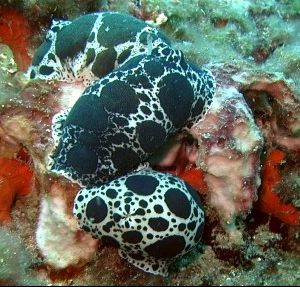
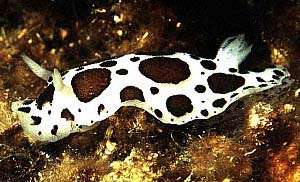
Peltodoris atromaculata
Bergh, 1880
Order: NUDIBRANCHIA
Suborder: DORIDINA
Family: Dorididae
DISTRIBUTION
Mediterranean and nearby Atlantic coasts.
PHOTO
UPPER: On food sponge Petrosia ficiformis, near Chalkidiki, Greece, March 2000. Photo: Claudia Gravenstein.
LOWER: Capoliveri, Elba, Italy. July 02, 1997, depth: 25m, size: 5 cm. divesite: Stella. Photo: Erwin Koehler.
LOWER:
Note added 8 August 2007: Valdes (2002) considers Peltodoris to be anatomically distinct from Discodoris. Since Peltodoris atromaculata is the type species of the genus it is illogical to retain it in Discodoris. [see message #20135]. I will rewrite this Fact Sheet when I get time.
See Avila (1996) for a good review of the natural history and biology of D. atromaculata, which was known for many years as Peltodoris atromaculata. Most authors now consider it to be a species of Discodoris, but some, like Avila consider there are anatomical features which distinguish it from that genus. Thompson (1985) describes a cline in colour pattern from west to east in Mediterranean, with specimens in the eastern Mediterranean having proportionally more dark brown/black pigment on the mantle than specimens from the western end. It feeds on the sponge Petrosia ficiformis (Poiret) and spends much of its time on the sponge. It accumulates natural chemical products, such as petroformynes, from the sponge and stores them in its digestive gland. It is able to autotomise parts of its mantle skirt but defense seems to rely on its spiculate mantle and disruptive coloration rather then defensive secretions, as the mantle secretions have been shown to have a neutral ph. It can grow to approx 120mm in length.
Reference:
• Avila, C., (1996) The growth of Peltodoris atromaculata Bergh, 1880 (Gastropoda, Nudibranchia) in the laboratory. Journal of Molluscan Studies, 62: 151-157.
See D. atromaculata - References for a list of references on the biology and natural history of this species.
A selection of photos of this characteristic species can be found at Erwin Koehler's Mediterranean Slug Site.
Authorship detailsRudman, W.B., 2001 (April 28) Peltodoris atromaculata Bergh, 1880. [In] Sea Slug Forum. Australian Museum, Sydney. Available from http://www.seaslugforum.net/find/discatro
Related messages
Peltodoris atromaculata abnormality
September 9, 2009
From: Antoni López-Arenas i Cama
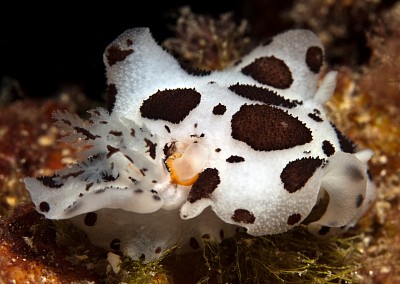
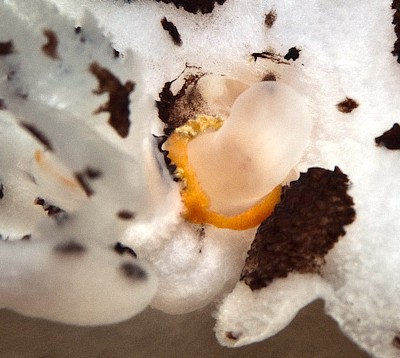
Dear Bill,
We found this specimen of Peltodoris atromaculata on a day the current was flowing strongly. I think that is the reason I could take photographs of its gills expanded and the undulating mantle, but I'm not really sure...
Do you think that the protuberance surrounded by a yellow ring is a reproductive organ in a wrong place or another abnormality?
Locality: Costa Brava, Tossa de Mar., 23 metres, Spain, Mediterranean, 29 August 2009, Pre-coraligen. Length: 5 cm. Upper Photos: Antoni Lopez-Arenas i Cama. Lower Photo: Marc Bosch
Thank you and best wishes,
Antoni Lopez-Arenas i Cama.
http://bitxosdelmediterrani.blogspot.com
http://www.flickr.com/photos/alopezarenas/sets/72157603891082971/
alopezarenas@gmail.com
López-Arenas, A., 2009 (Sep 9) Peltodoris atromaculata abnormality. [Message in] Sea Slug Forum. Australian Museum, Sydney. Available from http://www.seaslugforum.net/find/22636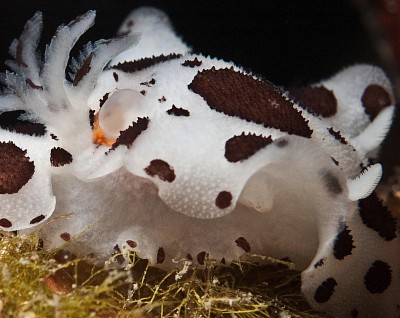
Dear Antoni,
I first thought this might be an example of a parasitic crustacean, but the damage to the mantle is quite extensive so I suspect that it is the result of a predator's bite. Interpreting anatomical peculiarities from photos is a bit risky, but I suspect the thin-walled 'balloon' which is poking out is part of the pericardium, which is a blood-filled sac surrounding the heart. The heart is just beneath the surface and just in front of the gills. The heart is very close to the gills because one of its main functions is to pump oxygenated blood around the body - and the gills is where oxygen from sea water is transferred to the blood. If you look at a dorid, you will often see a small swelling in front of the gills which is pulsating - that is the heart at work. I suspect the orange ring around the 'balloon' is the kidney - although I am puzzled by its colour. The kidney forms a layer just below the mantle in the same area. Its function is similar to our kidney. The other possibility is that the orange tissue is the blood gland, which is a thin flattened gland which is often over-looked in dissections. Various functions concerning the blood have been suggested for this organ, but unless I have missed some recent work, we really don't seem to know what its real function is.
So in summary, I think the thin-walled balloon is part of the pericardial sac which has popped out when something bit away a part of the slug's body wall.
Best wishes,
Bill Rudman
Re: Peltodoris atromaculata with damaged mantle
June 12, 2009
From: M. Baki Yokes
Concerning message #22451:
Dear Dominique and Bill,
I witnessed several times that the two crabs, Pilumnus hirtellus and Liocarcinus corrugatus cut up the slugs they meet in the aquarium. They don't eat them, or try to eat them, but when they catch them, they completely destroy the slugs.
Regards
Baki
bakiyokes@turk.net
Yokes, M.B., 2009 (Jun 12) Re: Peltodoris atromaculata with damaged mantle. [Message in] Sea Slug Forum. Australian Museum, Sydney. Available from http://www.seaslugforum.net/find/22521Dear Baki,
This is an obvious addition to the ' What eats sea slugs?' page. We tend to forget crabs, but if the carnivorous ones cause as much damage in nature as they do in aquaria, then they are probably a major cause of damage and death.
Best wishes,
Bill Rudman
Re: Peltodoris atromaculata with damaged mantle
May 27, 2009
From: Dominique Horst
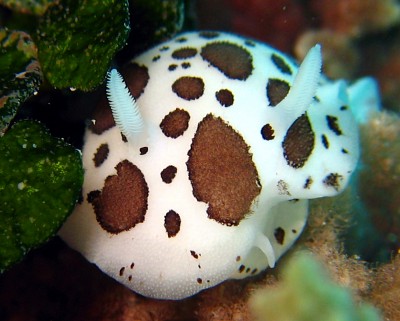
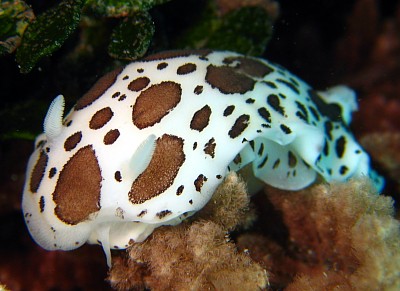
Concerning message #7303:
Hi Bill,
Another doris with a large bite in the mantle. This Discodoris atromaculata seems to be bitten on the head part. It's strange as it is exactly the same position as in Platydoris argo I reported in message #21846.
Locality: Antibes, 12 m, France, Mediterranean sea, 9 May 2009. Length: 5 cm. Photographer: Dominique Horst.
Kind regards,
Dominique
dominique.horst@wanadoo.fr
Horst, D., 2009 (May 27) Re: Peltodoris atromaculata with damaged mantle. [Message in] Sea Slug Forum. Australian Museum, Sydney. Available from http://www.seaslugforum.net/find/22451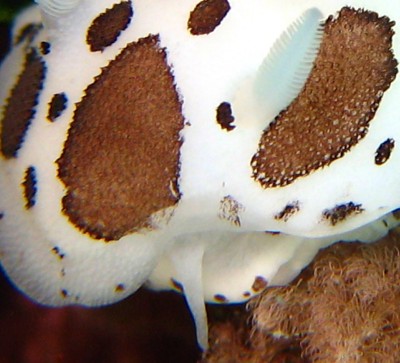
Dear Dom.,
Slugs have no real eyesight so it's their front end which is going to sustain any damage if they make an mistake in which direction they travel. This species is well supplied with distasteful chemicals in its mantle, and the way it openly displays itself suggests it is not greatly affected by fish attack. I would assume a fish attack could come from any direction, so perhaps the damage at the front of the mantle is related to mistakes they make when moving forward. Perhaps they mistakenly crawl into a crevice occupied by a large crab, or a fish, either of which could 'bite' more out of surprise than hunger.
Perhaps someone else has thoughts on this?
As you will see in a recent message [#20135] I have followed recent work and changed the name of this species to Peltodoris. Talking to Benoit Dayrat this week, he tells me that he has an enormous paper, which is about to be published, which leaves almost nothing in the genus Discodoris. No doubt a few hearts will flutter at the thought of another round of name changing. While my logical brain welcomes the clarification such research produces, my emotional brain will emit a small scream at the extra work that will be needed to change the many names on the Forum that will be affected.
Best wishes,
Bill Rudman
Peltodoris atromaculata from North Cyprus
April 8, 2008
From: Carol Cox
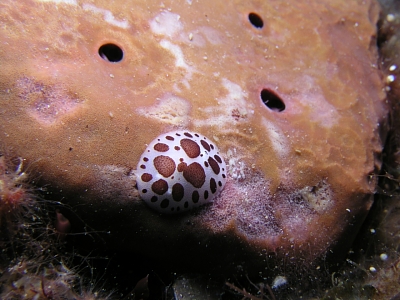
Concerning message #20135:
I didn't see any photos of Peltodoris atromaculata this far east in the Mediterranean, so I thought I would add it to your forum. You can see the scars on the sponge it was feeding on, although it wasn't actively feeding at the time of this photo.
Locality: Kyrenia, 55 ft, North Cyprus, Mediterranean, 1 August 2007, Rocky. Length: 15mm. Photographer: Carol Cox.
Carol Cox
ccox@mchsi.com
Cox, Carol, 2008 (Apr 8) Peltodoris atromaculata from North Cyprus. [Message in] Sea Slug Forum. Australian Museum, Sydney. Available from http://www.seaslugforum.net/find/20995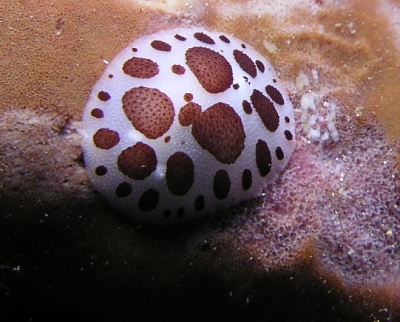
Dear Carol,
Petrosia ficiformis is reported to be the food sponge of this species throughout its range, which I am pretty sure covers all of the Mediterranean and the nearby Atlantic coast. Thanks for this nice photo showing the feeding scars.
Best wishes,
Bill Rudman
Peltodoris atromaculata from southern Portugal?
August 11, 2007
From: Pedro Alexandrino Monteiro
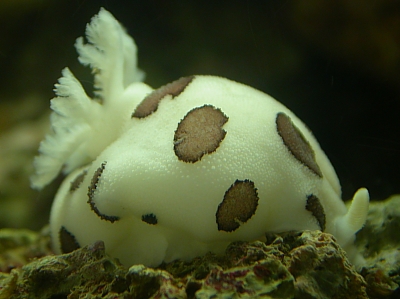
Dear Bill.
Here are some photos of a sea slug specimen that was collected just a few days ago between the localities of Albufeira and Armação de Pêra (Algarve, South of Portugal). I've identified them as Discodoris atromaculata. Can you confirm this identification? This is an adult specimen was more than 40 mm.
Locality: Between Albufeira and Armação-de-Pêra, 20 - 24 metres, Algarvel (South of Portugal) , Atlantic Ocean, 23 Setember 2007, found attached under rock. Length: more than 40 mm. Photographer: Pedro Monteiro.
Best regards,
Pedro Alexandrino Monteiro
P.S. Project RENSUB II: CCMAR-CCDRALG-DRAOTA: "Cartography and characterization of the marine communities off the National Underwater Ecological Reserve between Galé and Ancão"
FCMA/CCMAR
Universidade do Algarve
Campus de Gambelas
8005-139 Faro,
Algarve, Portugal
pmontei@ualg.pt
Monteiro, P., 2007 (Aug 11) Peltodoris atromaculata from southern Portugal?. [Message in] Sea Slug Forum. Australian Museum, Sydney. Available from http://www.seaslugforum.net/find/20135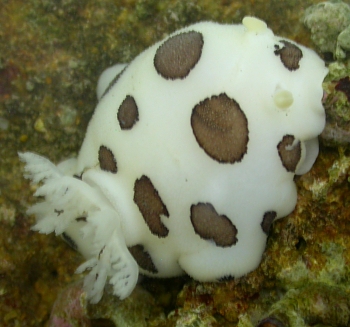
Dear Pedro,
Yes this is Discodoris atromaculata but I see in the latest checklist of the region (Cervera et.al, 2006) the genus name Peltodoris is used. This species is in fact the type species of Peltodoris (see Valdes, 2002) which means it is the species on which the genus is based. Since I am accepting Peltodoris nobilis on the Forum it would be illogical not to include the type species, P. atromaculata, as well. So am changing the name of this species on the Forum back to its original name Peltodoris atromaculata.
-
J. L. Cervera, G. Calado, C. Gavaia, M. A. E. Malaquias, J. Templado, M. Ballesteros, J. C. García-Gómez & C. Megina. (2006) An annotated and updated checklist of the opisthobranchs (Mollusca: Gastropoda) from Spain and Portugal (including islands and archipelagos). Boletín Instituto Español de Oceanografía 20 (1-4): 1-122
-
Valdés, A. (2002) A phylogenetic analysis and systematic revision of the cryptobranch dorids (Mollusca, Nudibranchia, Anthobranchia). Zoological Journal of the Linnean Society 136: 535-636.
Best wishes,
Bill Rudman
Discodoris atromaculata feeding
June 7, 2007
From: Anne Kloeppel
Hello,
I`m cultivating sponges for my PhD including some sponges of the species Petrosia ficiformis, which Discodoris atromaculata lives on. When I collected the sponges [Croatia, Northern Adriatic Sea] I didn`t see any Discodoris. Back in the aquarium however one ate all the sponges so nothing is left over. It has got really huge over time but I think it is is hungry now. Is there a possibility to feed it in an aquarium? Does it just feed on Petrosia ficiformis?
Thanks for your answer!
Greetings
Anne
anne.kloeppel@bio.uni-stuttgart.de
Kloeppel, A., 2007 (Jun 7) Discodoris atromaculata feeding. [Message in] Sea Slug Forum. Australian Museum, Sydney. Available from http://www.seaslugforum.net/find/19237Dear Anne,
I am afraid you message was caught up in the large backlog so it may be a bit late for the Discodoris. As we study sponge-feeding dorids in more detail we are finding that many have very specific diets. There is a list of references on the Forum to research on the biology of Discodoris atromaculata. I think you will find that it only feeds on Petrosia ficiformis. In your studies it would be interesting to know what other dorid nudibranch you find feeding on particular sponges
Best wishes,
Bill Rudman
Discodoris atromaculata from Croatia
March 30, 2006
From: Gearoid Lane
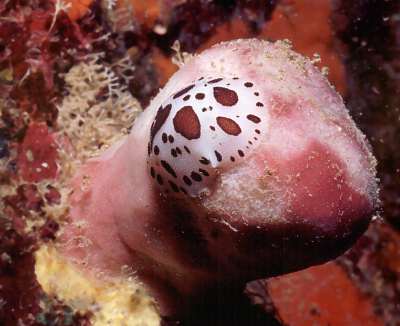
Dear Bill,
Can you identify this one?
Locality: Vela Luka, Korcula, 20m, Croatia, Adriatic, June 2005, On a sponge. Length: 10mm. Photographer: Gearoid Lane.
Gearoid Lane.
gearoid@gearoid.co.uk
Lane, G.M., 2006 (Mar 30) Discodoris atromaculata from Croatia. [Message in] Sea Slug Forum. Australian Museum, Sydney. Available from http://www.seaslugforum.net/find/16187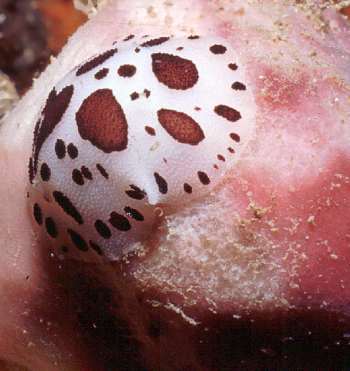
Dear Gearoid,
This is a nice photo of Discodoris atromaculata on its food sponge Petrosia ficiformis. In the close up alongside you can see where it has scraped the outer layers of the sponge.
Best wishes,
Bill Rudman
Discodoris atromaculata on Petrosia ficiformis
January 13, 2006
From: Stephane Ores
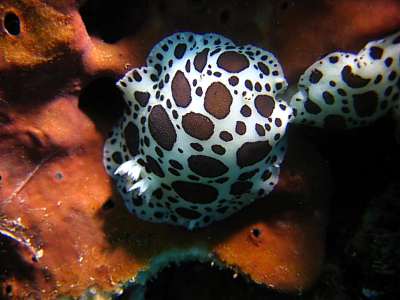
Hi Bill !
Discodoris atromaculata is a pretty common nudibranch, in the French Mediterranean coast.
On this picture, it's interesting to see how the sponge Petrosia ficiformis is eaten by the dorid
Locality: Cap Ferrat, near Nice, France. Mediterranean Sea. Depth: 15 m. Length: 40 mm. 24 July 2005. good visibility. Photographer: Stephane Ores
Stephane Ores
stephane.ores@neuf.fr
Ores, S., 2006 (Jan 13) Discodoris atromaculata on Petrosia ficiformis. [Message in] Sea Slug Forum. Australian Museum, Sydney. Available from http://www.seaslugforum.net/find/15542Thanks Stephane,
The dorid certainly seems to have bitten off a very noticeable section of the sponge
Best wishes,
Bill Rudman
Re: Discodoris atromaculata from Greece
February 25, 2004
From: Andrej Jaklin
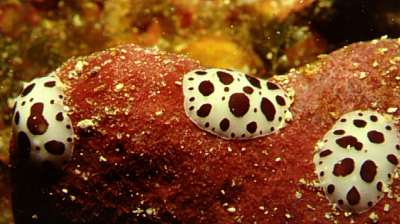
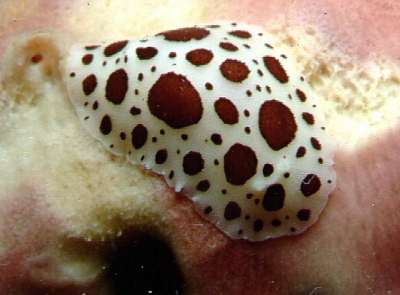
Dear Bill,
Concerning Bakis' message #12294:
Since this is a kind of exotic species to you, here are two more Discodoris atromaculata "conventions" from the Adriatic Sea. The second shot might be interesting because of visible food-sponge damage on the surface.
Although this is a common, if not a very common species here around, I never ever saw its egg-mass in situ! I'm wondering if out there is someone with a slide or personal experience with that?
Best regards,
AJ
jaklin@cim.irb.hr
Jaklin, A., 2004 (Feb 25) Re: Discodoris atromaculata from Greece. [Message in] Sea Slug Forum. Australian Museum, Sydney. Available from http://www.seaslugforum.net/find/12303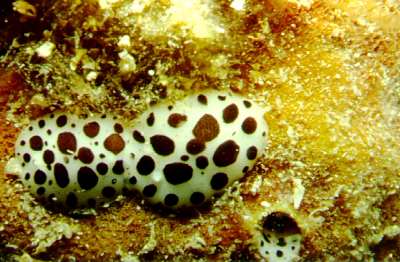
Thanks Andrej,
Seeing photos like this of a population in situ certainly underline just how 'obvious' and 'blatant' this species is. There seems to be little attempt to avoid potential predators, quite different from the cryptic and 'behaviourally timid' species from the Indo-West Pacific such as Discodoris lilacina which are seldom seen during the day and never in large numbers such as this. It certainly underlines the importance of the defensive chemicals these animals store in their bodies. [See D. atromaculata - References for a list of references on the biology and natural history of this species].
Best wishes
Bill Rudman
Re: Discodoris atromaculata from Greece
February 24, 2004
From: Baki Yokes
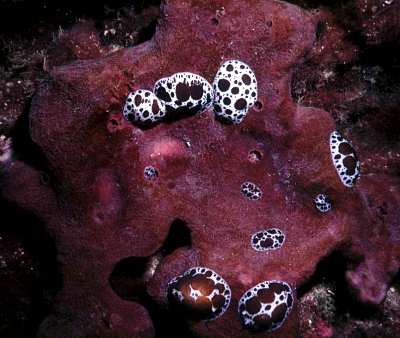
Dear Mihalis and Bill,
Concerning message #12270:
Discodoris atromaculata is more common on the North Aegean Sea (Saros Bay)along the Turkish coasts, where the the density of sea water ranges between 1.023-1.026. I think it will not be a problem to acclimatize this species to tropical 1.025, but, it is very very difficult to keep its food sponge, Petrosia ficiformis, alive in an aquarium (I tried and failed). As far as I observe, the sponge is common only in certain locations on the Aegean and Mediterranean Turkish coasts, which suggests some specific environmental conditions are needed.
Photo: Saros Bay (North Aegean), Turkey. Dive site: Ibrice. Depth: 24m. Date: May 1999.
Best wishes
Baki
bakiyokes@turk.net
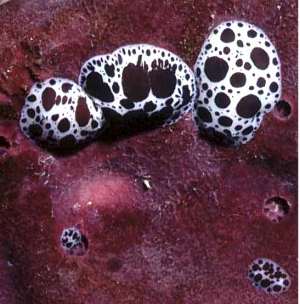
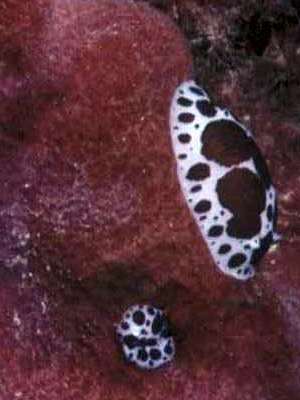
Dear Baki,
Thanks for the photo of the Discodoris convention. I didn't realise they could be so abundant. As you say, keeping the food items alive and healthy, is one of the main stumbling blocks to keeping nudibranchs in aquaria.
Best wishes
Bill Rudman
Discodoris atromaculata from Greece
February 23, 2004
From: Mihalis Polyadis
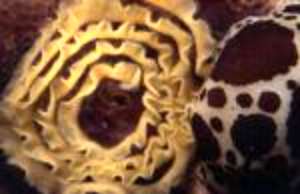
Hi.
I am sending this message from Athens -Greece. I scuba dive and I am interested in seting up a tropical marine aquarium (SG 1025). (I already have one fresh water planted aquarium with Cichlids in it).
During some of my dives I saw the cow-colored species in the included photo. Do you know the scientific name or where can I look for further information. The dives took place 10 Miles Southern the city of Athens at Saronikos, Vouliagmeni Beach, (Aegean sea) and the depth was about 5-7 meters.
I also would like to know if i can acclimatize this ''cow snail'' to live from the Aegean's 1031 into tropical water's 1025. By the way your job with this site and the informations given are excellent.
Thank you in advance for your reply
Mihalis Polyadis
captmike@otenet.gr
Polyadis, M, 2004 (Feb 23) Discodoris atromaculata from Greece. [Message in] Sea Slug Forum. Australian Museum, Sydney. Available from http://www.seaslugforum.net/find/12270Dear Mihalis,
I am pretty sure your animal is Discodoris atromaculata which is a fairly common Mmediterranean nudibranch. I can't imagine the difference in Specific Gravity will cause any problem for the slug in your aquarium but what may cause a problem is its food.
Most nudibranchs are very specific feeders, each species eating only one or a few species of the type of animal they feed on. For example a nudibranch that eats sponges will not eat all sponges, but will only eat one or two closely related species. Discodoris atromaculata apparently only eats the sponge Petrosia ficiformis. There is a photo of the sponge in the species Fact Sheet. However, even if you can find the sponge while diving, you will have great difficulty keeping the sponge alive in your aquarium for the slug to feed on. Even healthy sponges are very difficult to keep alive in closed aquarium systems, but you are going to try and keep a sponge in your aquarium which is being eaten alive!
My advice is for you to look and appreciate the nudibranchs while you are diving, and leave your aquarium for animals which are less difficult to maintain in aquarium conditions
Best wishes
Bill Rudman
Discodoris atromaculata from Adriatic
October 8, 2003
From: Adam Petrusek
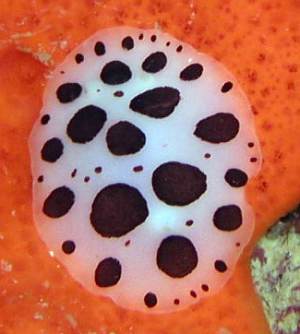
Dear Bill,
To accompany my earlier message, here is another sea slug from the Adriatic Sea, taken at Vrulja on Makarska Riviera, Croatia, on September 16, 2003.
This is of Discodoris atromaculata on the sponge Reniera fulva. We have encountered this slug several times on this orange sponge. I wonder whether it sometimes eats it, or was it just "on the walk" there? depth ~ 20 m
Thanks for the help.
Adam Petrusek
Charles University
Prague, Czech Republic
petrusek@cesnet.cz
Petrusek, A,, 2003 (Oct 8) Discodoris atromaculata from Adriatic. [Message in] Sea Slug Forum. Australian Museum, Sydney. Available from http://www.seaslugforum.net/find/11148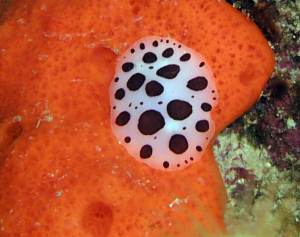
Thanks Adam,
As far as I know, this species has only been reported to feed on Petrosia ficiformis. The only way to be sure is to look for signs of feeding - either holes in the sponge or mouthparts everted. You can check for everted mouth parts by gently pulling the slug off the sponge and see if there is a tube attached to the sponge. Usually if you disturb a slug while feeding you will see it withdrawing the tube back inside its mouth cavity
Best wishes
Bill Rudman
Discodoris atromaculata from Holland
July 1, 2003
From: Andy den Boer
Dear Bill,
I would like your comment on our followinhg observation on Saturday 14 June 2003. In the Oosterschelde, Netherlands. Divesite Het Sas van Goes. 4 meters deep on two different stones; 5 Dotted sea-slugs with eggs. I have seen them on Lanzarote [Canary Ids] in December 2002, so I am fairly sure they are Discodoris atromaculata, yet I don't know of any diver who has spotted them in the Oosterschelde before.
Do you know which other species it maybe might have been? We will go there next week with a camera and w'll try to find out what it feeds on.
Greetings
Andy
andy.denboer@pandora.be
Dear Andy,
Discodoris atromaculata is quite a distinctive species. I don't know of any records from so far north so if your identification is correct it would be an exciting find. I look forward to seeing a photo of them. Hopefully they will still be there when you return
Best wishes
Bill Rudman
Discodoris atromaculata egg-ribbon
July 28, 2002
From: Marina Poddubetskaia
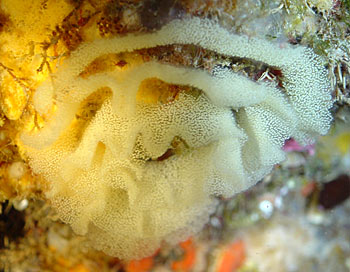
Dear Bill,
I noted that you haven't any photo of the egg-ribbon of Discodoris atromaculata, which is rather common and well known in France. The animal is extremely sensitive, and it's very difficult to photography it with its gills expanded.
Date: July 04, 2002
Location: Cerbere, France
Site: L'Ocell
Depth: 16m
Size of egg-ribbon: 4-5cm
Photos: Marina Poddubetskaia - Nembro website
Best wishes,
Marina.
nembro@nembro.info
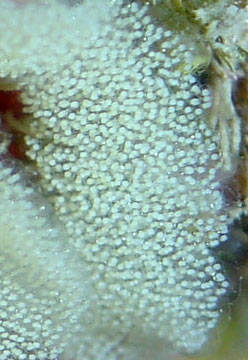
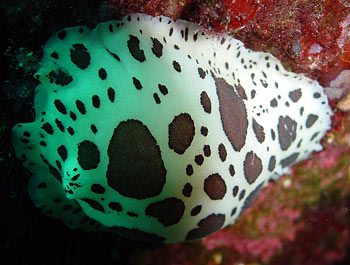
Thanks Marina,
Any 'biological' and 'natural history' information is always welcome. As I discussed with Nishina's photo of a Phyllidiella egg ribbon, we have much to learn about even the most common species.
Best wishes,
Bill Rudman
Discodoris atromaculata from France
June 28, 2002
From: Marina Poddubetskaia
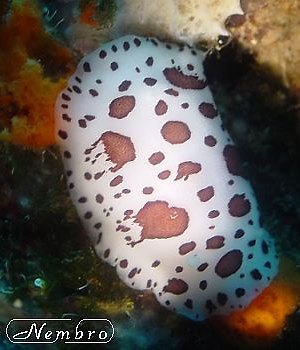
Dear Bill,
There are some photos of Discodoris atromaculata. This nudibranch is rather common in French Mediterranean.
UPPER: Cap Croisette (near Marseille), France. Site : Pierre qui tramole., Depth: 13m, Size : 5-6 cm. June 04, 2002
LOWER LEFT: Cap Croisette (near Marseille), France. Site: Les fromages, Depth: 12m, Size: about 9 cm. June 06, 2002
LOWER RIGHT:
Photo 3 Cap Croisette (near Marseille), France. Site: Tiboulen de Maire., Depth: 15m,
Size: 7-8 cm. June 04, 2002
Best wishes,
Marina.
www.nembro.info
nembro@nembro.info
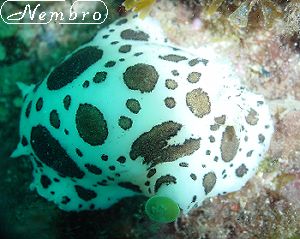
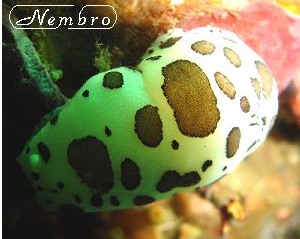
Thanks Marina,
Bill Rudman
Discodoris atromaculata from Greece
March 19, 2002
From: Fons Sarneel
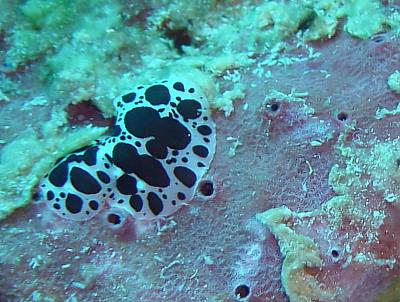
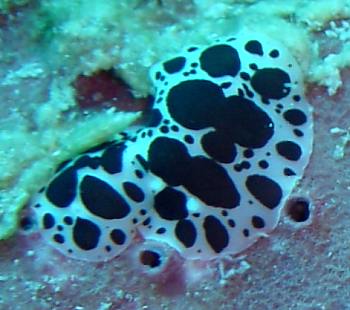
Dear Bill,
Last year, [31 August 2001], my wife and I were diving near the island Crete, Greece. To be specific, we were at the coast of the isle "Dia", which is an uninhabited "rock" close to the north coast of Crete.
There we saw these slugs (?). I suppose they're known species. We found them at a depth of somewhere between 15 and 25 meters.
Yours sincerely,
Fons Sarneel
fons@sarneel-2.myweb.nl
Sarneel, S., 2002 (Mar 19) Discodoris atromaculata from Greece. [Message in] Sea Slug Forum. Australian Museum, Sydney. Available from http://www.seaslugforum.net/find/6462Dear Fons,
Thanks for this photo and the other which I'll post separately. This is Discodoris atromaculata which is a fairly common Mediterranean species, often found on its food sponge Petrosia ficiformis. I presume the sponge in your photo is that species. It seems to range in colour from this purple form to an off-white.
In an earlier message there is a photo of a darker form of this slug from Greece. I discuss there an idea that had been proposed suggesting that eastern populations of this species in the Mediterranean were darker than those at the western end. Your animals are as 'white' as any I have seen from the western Mediterranean so they certainly don't fit the theory.
Best wishes,
Bill Rudman
Discodoris atromaculata from Greece
April 29, 2001
From: Peter H. van Bragt
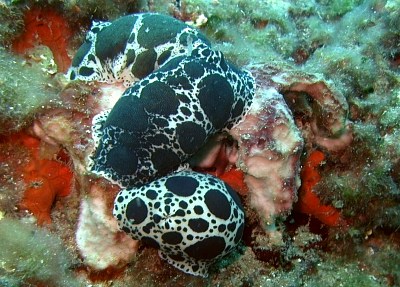
Dear Bill,
The attached picture was taken in Greek Mediterranean waters near Chalkidiki in March 2000 by Claudia Gravenstein from Belgium. She asked me to verify the species name but also gave me permission to post the slides on the Forum.
Obviously they are Peltodoris atromaculata or also called Discodoris atromaculata, which ever name came first. As this species seems to be rather variable in appearance I thought it might be nice to add these specimen also to the collection of the Sea Slug Forum.
With best regards
Peter H. van Bragt
vanbragt.phjm@hsbrabant.nl
van Bragt , P.H., 2001 (Apr 29) Discodoris atromaculata from Greece. [Message in] Sea Slug Forum. Australian Museum, Sydney. Available from http://www.seaslugforum.net/find/4243Thanks Peter,
Yes this photo is a nice addition to the Forum as it shows a darker colour form than usually photographed and also quite a bit of variability in colour at one location.
Firstly about the name. In this case it is not a case of 'which came first' but which genus it should belong to (Discodoris or Peltodoris?) . The 'law of priority' - which name comes first - only applies to the species word, in this case atromaculata. In this case there is an added problem because we are not sure whether there are sufficient anatomical differences between the genera Discodoris and Peltodoris to consider then to be two distinct genera in the first place. I am calling it Discodoris, because that seems to be the present usage among Mediterranean workers.
Now to the colour differences. It has been suggested that there is a gradual change (or cline) in colour pattern in this species from west to east, with the colour gradually darkening towards the east. Most photos I have seen are from the western end of the Mediterranean and they certainly have a higher proportion of white than these animals from Greece. However the animal in the front of the photo seems to have much more white than the other two in the photo, more like those from the western Mediterranean. Clearly three isn't a very good sample of the Greek population and even if the population was on the whole darker, you would expect to find a few lighter coloured animals as well.
I have added some more information to the D. atromaculata Page and have added a page listing some relevant References to aspects of its biology and natural history.
Please pass on my thanks to Claudia,
Best wishes,
Bill Rudman
Re: Food of Discodoris atromaculata
February 15, 1999
From: Juan Vicente López-Canales
Hy Bill!
Thanks for your answer. I try to send to you some photos about the place where I dive and "collect" the Discodoris and some photos of this animals.
The last I saw in the stomach of one of this animals is a kind of jelly with some Petrosia spicules. I think it could be to protect the stomach, but I try "investigating" this.
See you at the web. Bye.
Juan Vicente.
juanvicente.lopez@uca.es
López-Canales, J.V., 1999 (Feb 15) Re: Food of Discodoris atromaculata. [Message in] Sea Slug Forum. Australian Museum, Sydney. Available from http://www.seaslugforum.net/find/562Dear Juan Vicente,
I look forward to some photos and to hear some more about your studies.
Bill Rudman.
Re: Photo of Discodoris atromaculata
February 1, 1999
From: Erwin Koehler

Bill,
Here's a photo of Discodoris atromaculata. It is from Capoliveri, Elba, Italy. July 02, 1997, depth: 25m, size: 5 cm. divesite: Stella.
Erwin
E.Koehler@deutschepost.de
Koehler, E., 1999 (Feb 1) Re: Photo of Discodoris atromaculata. [Message in] Sea Slug Forum. Australian Museum, Sydney. Available from http://www.seaslugforum.net/find/527Thanks Erwin,
I've added it to the top of the page
Bill Rudman.
Food of Discodoris atromaculata
January 28, 1999
From: Juan Vicente López-Canales
I´m a student of "Science of the Sea" at the Cádiz University and I am interested in the biology of the Discodoris atromaculata specially in its food. I know that this animal eats normally Petrosia but could it eat other sponge like Haliclona?
(Sorry for my bad english)
I would like to be included in the participants page:
Juan Vicente López-Canales
Dpto. Biología Animal, Vegetal y Ecología
Aptdo 40
Pto.Real (Cádiz)
Spain
juanvicente.lopez@uca.es
López-Canales, J.V., 1999 (Jan 28) Food of Discodoris atromaculata. [Message in] Sea Slug Forum. Australian Museum, Sydney. Available from http://www.seaslugforum.net/find/519Dear Juan,
Perhaps someone can help us with your question. I only know of records of it feeding on Petrosia ficiformis. Many dorids are extremely specific about their food, and it is possible D. atromaculata is such a species.
Good luck with your study. If you have photos or information on D. atromaculata or any other sea slugs you would like to share, they would be very welcome.
And don't worry about your English - it's a lot better than my Spanish!
Bill Rudman.
